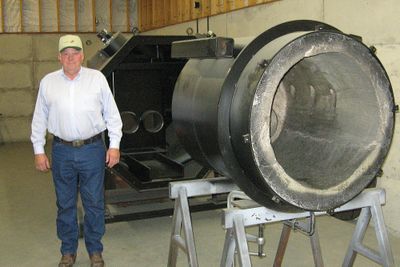Inventive Colville man gives life to wood-to-energy technology

COLVILLE – Dale Borgford has manufactured tractor blades, claws, grapplers and other equipment for farm and timber industry use in his Colville shop for 29 years.
Simple work compared with the project he and Stevens County officials hope to launch soon at the Kulzer BioEnergy Park, the site of a demolished sawmill on Highway 231 near Valley.
With the support of $4.25 million in federal economic stimulus money, they expect to create at least 40 jobs and put the county at the forefront not only of new energy technology, but an emerging field of soil science focused on charcoal-like biochar.
Borgford said total investment could reach $19 million, much of that provided by his family.
He will receive $4 million of the federal money to build the first of four Borgford BioEnergy Octaflame Gasification Systems, each capable of generating more than one megawatt of electricity for sale to Avista or other area utilities.
The rest, $250,000, will fund stepped-up removal of the brush, small trees and debris that have been accumulating in the area’s woods, awaiting only a spark to feed a conflagration. The material will be fed into the gasifiers.
The project is one of 30 – and the only in Washington – announced last month by the U.S. Department of Agriculture. The $57 million wood-to-energy program will help clean up the nation’s forests and create new energy infrastructure, Deputy Secretary Kathleen Madigan said.
The Kulzer project will start with site preparation for a community center/Borgford office site, but the real centerpieces will be the gasifiers. The devices, each the size of a small room, will generate electricity as well as byproducts like distilled water, bio-oil and, perhaps most importantly, jobs.
In June, Stevens County had an unemployment rate of 12.4 percent, nearly double the 7 percent of a year ago.
“Life isn’t much fun without a job,” Borgford said.
He said he began work on his gasifier more than 20 years ago, when a company brought in a burner design for development. After trial and error, he came up with the present design. But the company that came into the shop with the original design was long gone, he said.
“They quit short of the finish line,” Borgford said. “I never quit studying it.”
His studies culminated with a demonstration plant about the size of a telephone booth on its site. He had the unit broken down for painting during a reporter’s visit. The octagonal-chamber that concentrates the heat gives the Octaflame its name.
Although he said he is unconcerned about patents, Borgford is guarded when asked about the technology that enables his gasifier to produce extremely high temperatures. But the basics of pyrolysis, or “cooking wood,” are well understood.
Depending on whether the wood or other carbon-material is cooked in the presence of oxygen, a combination of several fuels and byproducts is possible. The most common example is charcoal, a form of biochar.
Although charcoal has been used to improve soils for millennia, development of a commercial market for biochar is in its infancy, said Max DeRungs, owner of Portland-based Cascadia Biochar. He helped organize a May biochar conference in Richland.
Besides its value as a soil additive, he said, biochar also captures some of the carbon that otherwise would be combusted into carbon dioxide, a greenhouse gas. There’s a market for that carbon “sequestration,” he said.
DeRungs, who said he saw a sketch of Borgford’s gasifier at the conference, predicted grassroots experimentation by farmers and timber interests working with soil and other scientists will gradually create a biochar industry in the Northwest.
Stevens County Commissioner Merrill Ott said he is excited about the gasifier’s ability to diversify the area’s output of forest products by putting to good use logging slash and other materials that now go to waste.
But the transparency promised by President Barack Obama in the use of stimulus funds translates into a thicket of forms slowing Borgford’s progress toward groundbreaking, said Ott, who nevertheless added, “I’m confident we can do this and do it well.”
Borgford said the combination of rising fuel prices and the need to clear away forest debris suggested the time was right to build a commercial-scale gasifier. As soon as the paperwork can be overcome in time, and the grant money is in hand, he said, “We will be moving ahead very, very fast.”
He said he hopes to fire up the first gasifier by New Year’s.
“We’re going to something good for the (Colville) valley,” Borgford said.